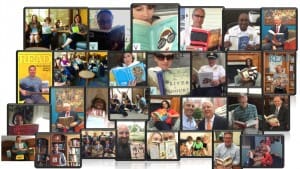2017 was an exciting year for The Literacy Cooperative. This year we expanded on some initiatives and began working with new ones. In Early Literacy, Reach Out and Read expanded to new sites and we began our work on the Dolly Parton Imagination Library Program. We launched our #WordGapCLE initiative, which is raising awareness about the importance of parents and caregivers talking, singing and reading with children from birth. We continued to expand our efforts with adult literacy and career pathways. We led the launch of healthcare and manufacturing contextualized curriculum and are getting ready to pilot a digital literacy contextualized curriculum. We also held a number of great professional development sessions along with our 7th annual Teacher Academy. Our 2nd annual Cleveland Corporate Spelling Bee (CLE-BEE) was a fantastic night of friendly competition and raising awareness about the importance of literacy. Our social media campaigns for Read Across America Day and International Literacy Day had great participation among our partners, community members, and elected officials. We wrapped up this year by launching our brand new website, www.literacycooperative.org. Continue to read below for more details on our initiatives, events and the other work we did this year!
Early Literacy Outcomes
 Reach Out and Read
Reach Out and Read
Building relationships has been a key strategy for our Reach Out and Read Coordinator Lynn Foran in 2017. Working through ROR Site Coordinators and Medical Champions at each clinic, 34,467 new books have been distributed to ROR-trained medical providers to share with families during well child visits with children under 5 years old, and 6,500 gently used books have been made available to children in literacy-friendly waiting rooms.
In 2017, ROR expanded from 23 to 30 active sites reaching families in key neighborhoods in Cleveland: Hough, East Cleveland, Collinwood, and Fairfax. ROR 2017 partners include MCPc, Barnes & Noble, PNC, Thompson Hine, Books-a-Million, West Shore Career-Technical Center, and WKYC.
Imagination Library
The Dolly Parton Imagination Library is a book gifting program that mails free books to children from birth to age five. The Dolly Parton Imagination Library expanded in Cuyahoga County this year as The Literacy Cooperative was selected to coordinate the outreach and registration of books to zip codes funded through The Bruening and Heights Family Foundations.
Through the Heights Family Foundation, TLC works with agencies, schools and libraries to enroll families in Cleveland Heights, University Heights, Shaker Heights, Euclid and East Cleveland. The Bruening Foundation’s support expands the reach to Bedford, Garfield, Maple and Warrensville. The objectives of the initiative are to increase families reading together, foster a love of reading in children, improve school readiness, and inform and connect to parents to promote local educational opportunities
Over the course of the year we have established strong relationships with over 48 partner sites. Nearly 4,000  children have been enrolled. Parents receive a welcome letter and monthly e-newsletters with reading tips, local free family-friendly events, and other resources for parents to explore with their children. We are connecting the Imagination Library to our Reach Out and Read partners to enroll families when they visit their pediatricians.
children have been enrolled. Parents receive a welcome letter and monthly e-newsletters with reading tips, local free family-friendly events, and other resources for parents to explore with their children. We are connecting the Imagination Library to our Reach Out and Read partners to enroll families when they visit their pediatricians.
#WordGapCLE

According to research, by the age of four, children in affluent families will hear 30,000,000 more words than a child in a family in poverty. The #WordGapCLE initiative was launched in connection with Read Across America Day on March 2nd. Dr. Dana Suskind, author of Thirty Million Words, Building a Child’s Brain, was our luncheon keynote speaker. She touched upon the importance of parents and caregivers talking, singing and reading with a child especially from birth to age three. Building upon her research, we developed posters and rack cards emphasizing the four T’s (Tune In, Talk More, Take Turns, Turn Off) of developing a baby’s brain, which were distributed to doctor offices, business, community organizations and adult literacy agencies. The initiative continued throughout the year with blog posts and a social media campaign to raise awareness about the word gap.(To see more search #WordGapCLE on Twitter). This initiative was linked to Slavic Village’s literacy friendly neighborhood campaign, #SlavicVillageReads.
STEP
STEP (Supporting Tutors Engaging Pupils) served K-4 students in five elementary schools in three school districts: Fullerton School of Academics, George Washington Carver STEM, and Marion-Sterling in Cleveland Metropolitan School District; John Dewey in Warrensville Heights City School District; and Shoreview Elementary in Euclid City School District. The volunteers were high school students from Cleveland Central Catholic and Warrensville High, JCU undergraduates, employees from Alcoa and adults from Grace Baptist Church. In total, the 104 volunteers provided 227 hours of service in tutoring 148 students. The student attendance ranged from 41% to 93% and averaged 74%. STEP students made the recommended yearly gains, and, in many cases, more than the recommended yearly gains.
Career Pathways Engagement
TalentNEO
The goal of TalentNEO is to increase opportunities for Northeast Ohio jobseekers by demonstrating the value of a skills based approach to attracting, screening, and hiring qualified candidates. By creating a common language of skills between employers and job candidates, TalentNEO will change how hiring is done across Northeast Ohio.
During the second year of the pilot, TalentNEO assessed 1,828 individuals to determine skill scores for career pathway and job  advancement opportunities through the WorkKeys assessments. 953 individuals requested upskilling assistance to increase their skill scores with 247 enrolling in staff assisted upskilling and the balance using the online self-directed tool.
advancement opportunities through the WorkKeys assessments. 953 individuals requested upskilling assistance to increase their skill scores with 247 enrolling in staff assisted upskilling and the balance using the online self-directed tool.
NEO Skills Corps
 NEO Skill Corps members strive to elevate the knowledge and education of adult job-seekers and entry-level employees with direct service in financial literacy training and basic skills instruction, including adult literacy. Members provide financial literacy training, adult education, workforce development preparation, and employment training with a focus on basic soft skills instruction. During the 2016-17 program year, 894 participants enrolled in financial literacy with 34% opening a bank account, 41% creating a budget, and 10% developing a debt management plan. For the adult education and workforce, of the 942 enrolled in services, 73% completed services, 114 obtained employment, and 681 took the WorkKeys assessments.
NEO Skill Corps members strive to elevate the knowledge and education of adult job-seekers and entry-level employees with direct service in financial literacy training and basic skills instruction, including adult literacy. Members provide financial literacy training, adult education, workforce development preparation, and employment training with a focus on basic soft skills instruction. During the 2016-17 program year, 894 participants enrolled in financial literacy with 34% opening a bank account, 41% creating a budget, and 10% developing a debt management plan. For the adult education and workforce, of the 942 enrolled in services, 73% completed services, 114 obtained employment, and 681 took the WorkKeys assessments.
Contextualized Curriculum
Contextualized Curriculum is instructional strategies designed to more seamlessly link the learning of foundational skills and academic or occupational content by focusing teaching and learning on concrete applications in a specific context that is of interest to the student. Our work with the contextualized curriculum implementation is one of the best examples of giving this community direct access to best practice information. Laureen Atkins, Director of Adult Literacy and Career Pathways, led the development, piloting, and implementation of contextualized curriculum.
In 2017, 45 students participated in Healthcare pilots, 5 students in a Manufacturing pilot, and 12 in a Hospitality pilot. Pilot sites included NewBridge, University Settlement, Lorain County Community College ABLE program, and Building Hope in the City. Results from the Healthcare pilots included NewBridge participants meeting the requirements necessary for registration into one of their healthcare training programs, and 67% of University Settlement participants successfully completing the sessions. Building Hope in the City had a 92% completion of their Hospitality program that provided the graduates with Ohio food handler certification.
Professional Excellence
Professional Development Sessions
More than 600 attendees participated in one or more of our 29 sessions of trainings, Literacy Learners Network,  Teacher Academy and special events. We partnered with Cuyahoga Community College, Towards Employment, Seeds of Literacy, Aspire Greater Cleveland, and Euclid Council of the International Reading Association to provide sessions on reentry transitioning, mental health symptoms and services and creative writing.
Teacher Academy and special events. We partnered with Cuyahoga Community College, Towards Employment, Seeds of Literacy, Aspire Greater Cleveland, and Euclid Council of the International Reading Association to provide sessions on reentry transitioning, mental health symptoms and services and creative writing.
Teacher Academy
 This year 115 teachers and administrators attended our 7th annual Teacher Academy. Our annual event gathers teachers representing the First Ring Suburbs and Cleveland Metropolitan School District for a full-day program featuring carefully selected educators who demonstrate to a ‘classroom’ of peers, the strategies and resources that have proven effective in their classrooms. This year was our largest number in attendance and the first year we had teachers from each of the 16 First Ring Suburbs as well as CMSD.
This year 115 teachers and administrators attended our 7th annual Teacher Academy. Our annual event gathers teachers representing the First Ring Suburbs and Cleveland Metropolitan School District for a full-day program featuring carefully selected educators who demonstrate to a ‘classroom’ of peers, the strategies and resources that have proven effective in their classrooms. This year was our largest number in attendance and the first year we had teachers from each of the 16 First Ring Suburbs as well as CMSD.
Events
Dr. Dana Suskind Luncheon
As part of our Read Across America Day celebration, Dr. Dana Suskind, author of Thirty Million Words Building a Child’s Brain, was our keynote speaker at a luncheon at the Wyndham Hotel with more than 170 in attendance. She spoke about the thirty-million-word gap and the importance of reading, talking and singing with a child from birth.
Read Across America Day
 TLC celebrated Read Across America Day for the 2nd year in a row on March 2nd with a social media campaign. Our #WordGapCLE initiative invited Greater Clevelanders to post pictures or videos of themselves reading, singing or talking with their children. If they didn’t have kids, we asked them to be an example and post a reading selfie. We had great participation including Representative Jim Renacci, Councilman Kevin Kelley, Cuyahoga County Executive Armond Budish, Cleveland Mayor Jackson and his staff, as well as a number of other Mayors and organizations across Northeast Ohio.
TLC celebrated Read Across America Day for the 2nd year in a row on March 2nd with a social media campaign. Our #WordGapCLE initiative invited Greater Clevelanders to post pictures or videos of themselves reading, singing or talking with their children. If they didn’t have kids, we asked them to be an example and post a reading selfie. We had great participation including Representative Jim Renacci, Councilman Kevin Kelley, Cuyahoga County Executive Armond Budish, Cleveland Mayor Jackson and his staff, as well as a number of other Mayors and organizations across Northeast Ohio.
CLE-BEE
On September 7th we held our 2nd annual Cleveland Corporate Spelling Bee (CLE-BEE), sponsored by Third Federal Foundation and Lubrizol. Twenty-seven teams joined together for a fun evening of competition and raising awareness about literacy. Celebrities participating included WKYC Meteorologist Betsy Kling, WTAM Sports Director Mike Snyder, Common Pleas Judge John Russo, singer/songwriter Michael Stanley, and Cleveland  Cavaliers radio voice Jim Chones. The final four teams included Cuyahoga Community College, United Way Services of Greater Cleveland, Medical Mutual of Ohio and Benesch Law. Ultimately, Benesch Law dethroned Baker Hostetler and became our 2017 spelling champions, taking home not only trophies but a customized football donated by the Cleveland Browns, and custom jerseys donated by the Indians and CAVS. Be sure to take a look at our Storify for a complete recap of the night.
Cavaliers radio voice Jim Chones. The final four teams included Cuyahoga Community College, United Way Services of Greater Cleveland, Medical Mutual of Ohio and Benesch Law. Ultimately, Benesch Law dethroned Baker Hostetler and became our 2017 spelling champions, taking home not only trophies but a customized football donated by the Cleveland Browns, and custom jerseys donated by the Indians and CAVS. Be sure to take a look at our Storify for a complete recap of the night.
International Literacy Day
For the 4th year in a row we led a community celebration of International Literacy Day on September 8th. This year  we built upon our #WordGapCLE theme and asked the community to share “How has literacy has empowered you?” using the hashtag #powerofwordsCLE. We received a number of great answers from Councilwoman Phyllis Cleveland, the Mayors of Parma Heights and Westlake, the President of Cleveland State University, President Berkman as well as a number of several patrons of the libraries.
we built upon our #WordGapCLE theme and asked the community to share “How has literacy has empowered you?” using the hashtag #powerofwordsCLE. We received a number of great answers from Councilwoman Phyllis Cleveland, the Mayors of Parma Heights and Westlake, the President of Cleveland State University, President Berkman as well as a number of several patrons of the libraries.
Common Ground
On July 30th, TLC took part in The Cleveland Foundation’s Common Ground event. The event was focused on building connections, valuing all voices and sharing ideas on how to move Greater Cleveland forward. Our Executive Director Bob Paponetti and Reach Out and Read Coordinator, Lynn Foran hosted a lunch talk about the Thirty Million Word Gap at the Maple Heights Library.
Public Policy and Advocacy
Speaking Engagements
Cleveland/Cuyahoga County Workforce Board One Direction Event -October – Our President & CEO Bob Paponetti was invited to speak about the importance of advancing literacy, especially digital literacy.
United Way Services of Greater Cleveland requested The Literacy Cooperative staff to speak at three committee meetings – education, income, and resource development; regarding the work of TLC and to educate the volunteers on the early literacy and adult education landscape in our community.
City Year – Our President & CEO was asked to share the work of TLC with the new class of City Year Members.
Live on Lakeside – Bob Paponetti and Board Vice-Chair, Emily Campbell appeared in August to promote the CLE-BEE as well as discuss our initiatives.
Radio – Mike Snyder, radio host of WTAM’s Cleveland’s Morning News with Wills and Snyder, invited Bob Paponetti to deliver the CLE-BEE words to him during his on-air show. Mike asked him to participate in The Spew with John Lanigan and Mike Trivisonno as well.
Coalition on Adult Education/Ohio Association for Adult and Continuing Education Regional Institute – TLC was a major sponsor for this event held at the Renaissance Hotel in downtown Cleveland. TLC sponsored the keynote speaker, Leslie Fisher, on October 6, 2017. Ms. Fisher, a national speaker on digital literacy learning, discussed with the group the history of technology and its importance in the classroom.
Pregnant With Possibilities’ Mommy & Me Ball. – On Sunday, September 24, TLC teamed up with Reach Out  & Read and WKYC to provide a literacy connection for over 50 moms and their children. Reach Out & Read provided a reading nook for moms and children to share a book with ROR volunteer readers. Each child selected a book to take home with them.
& Read and WKYC to provide a literacy connection for over 50 moms and their children. Reach Out & Read provided a reading nook for moms and children to share a book with ROR volunteer readers. Each child selected a book to take home with them.
National Conferences
National Skills Coalition. Laureen, our Director of Adult Literacy and Career pathways, attended The Skills Summit that was held in Washington DC and included opportunities for TLC to meet with U.S. legislators and staff as part of our Ohio Delegation.
In October, she attended the Skills in the States Forum in Nashville, TN to learn about workforce development and adult education strategies throughout the nation that focus on career pathway opportunities for low-skilled adults.
Dolly Parton Imagination Library Conference – Our President & CEO, Reach Out and Read Coordinator and Imagination Library Coordinator attended this conference. Sessions focused on emerging evidence and evaluations showing the impact of Imagination Library, new marketing materials were shared, and suggestions for fund development.
Advocacy
Our Director of Adult Literacy & Career Pathways submitted an editorial, “The Path to Better Jobs Starts with Literacy, and there’s help” that was published in The Plain Dealer and on Cleveland.com in June 2017. It was in response to an article focused on employers’ struggles in finding qualified workers. Congressman Jim Renacci’s staff contacted The Literacy Cooperative for comments on his bill to Help Ohioans Move from Welfare to Work.
TLC was asked to present to the 2016-2017 Leadership Cleveland 2 class that was focusing their efforts on early learning. After presenting our work around the Word Gap, Reach Out & Read, and Imagination Library, Bob Paponetti was asked to join the class. His participation led to the Word Gap selected as one of the initiatives supported by the class. This led to the creation of a Word Gap Task Force under Invest In Children.
We want to wish everyone a Happy Holiday and a fun and safe New Year. Be sure to follow our blog and our social media platforms (Facebook, Twitter, Instagram) for up-to-date information about our the progress of our initiatives and the other work we are doing to advance literacy in the Greater Cleveland area.

 Reach Out and Read
Reach Out and Read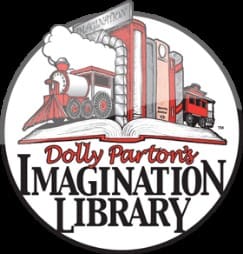 children have been enrolled. Parents receive a welcome letter and monthly e-newsletters with reading tips, local free family-friendly events, and other resources for parents to explore with their children. We are connecting the Imagination Library to our Reach Out and Read partners to enroll families when they visit their pediatricians.
children have been enrolled. Parents receive a welcome letter and monthly e-newsletters with reading tips, local free family-friendly events, and other resources for parents to explore with their children. We are connecting the Imagination Library to our Reach Out and Read partners to enroll families when they visit their pediatricians.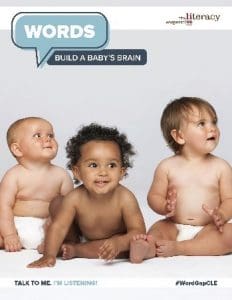

 Teacher Academy and special events. We partnered with Cuyahoga Community College, Towards Employment, Seeds of Literacy, Aspire Greater Cleveland, and Euclid Council of the International Reading Association to provide sessions on reentry transitioning, mental health symptoms and services and creative writing.
Teacher Academy and special events. We partnered with Cuyahoga Community College, Towards Employment, Seeds of Literacy, Aspire Greater Cleveland, and Euclid Council of the International Reading Association to provide sessions on reentry transitioning, mental health symptoms and services and creative writing.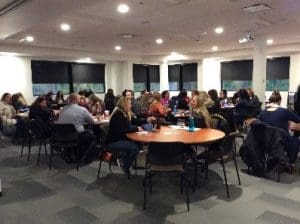 This year 115 teachers and administrators attended our 7th annual Teacher Academy. Our annual event gathers teachers representing the First Ring Suburbs and Cleveland Metropolitan School District for a full-day program featuring carefully selected educators who demonstrate to a ‘classroom’ of peers, the strategies and resources that have proven effective in their classrooms. This year was our largest number in attendance and the first year we had teachers from each of the 16 First Ring Suburbs as well as CMSD.
This year 115 teachers and administrators attended our 7th annual Teacher Academy. Our annual event gathers teachers representing the First Ring Suburbs and Cleveland Metropolitan School District for a full-day program featuring carefully selected educators who demonstrate to a ‘classroom’ of peers, the strategies and resources that have proven effective in their classrooms. This year was our largest number in attendance and the first year we had teachers from each of the 16 First Ring Suburbs as well as CMSD.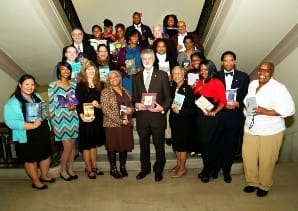 TLC celebrated Read Across America Day for the 2nd year in a row on March 2nd with a social media campaign. Our #WordGapCLE initiative invited Greater Clevelanders to post pictures or videos of themselves reading, singing or talking with their children. If they didn’t have kids, we asked them to be an example and post a reading selfie. We had great participation including Representative Jim Renacci, Councilman Kevin Kelley, Cuyahoga County Executive Armond Budish, Cleveland Mayor Jackson and his staff, as well as a number of other Mayors and organizations across Northeast Ohio.
TLC celebrated Read Across America Day for the 2nd year in a row on March 2nd with a social media campaign. Our #WordGapCLE initiative invited Greater Clevelanders to post pictures or videos of themselves reading, singing or talking with their children. If they didn’t have kids, we asked them to be an example and post a reading selfie. We had great participation including Representative Jim Renacci, Councilman Kevin Kelley, Cuyahoga County Executive Armond Budish, Cleveland Mayor Jackson and his staff, as well as a number of other Mayors and organizations across Northeast Ohio.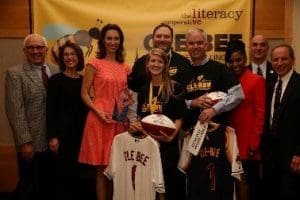 Cavaliers radio voice Jim Chones. The final four teams included Cuyahoga Community College, United Way Services of Greater Cleveland, Medical Mutual of Ohio and Benesch Law. Ultimately, Benesch Law dethroned Baker Hostetler and became our 2017 spelling champions, taking home not only trophies but a customized football donated by the Cleveland Browns, and custom jerseys donated by the Indians and CAVS. Be sure to take a look at our Storify for a complete recap of the night.
Cavaliers radio voice Jim Chones. The final four teams included Cuyahoga Community College, United Way Services of Greater Cleveland, Medical Mutual of Ohio and Benesch Law. Ultimately, Benesch Law dethroned Baker Hostetler and became our 2017 spelling champions, taking home not only trophies but a customized football donated by the Cleveland Browns, and custom jerseys donated by the Indians and CAVS. Be sure to take a look at our Storify for a complete recap of the night.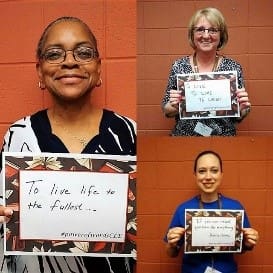 we built upon our #WordGapCLE theme and asked the community to share “How has literacy has empowered you?” using the hashtag #powerofwordsCLE. We received a number of great answers from Councilwoman Phyllis Cleveland, the Mayors of Parma Heights and Westlake, the President of Cleveland State University, President Berkman as well as a number of several patrons of the libraries.
we built upon our #WordGapCLE theme and asked the community to share “How has literacy has empowered you?” using the hashtag #powerofwordsCLE. We received a number of great answers from Councilwoman Phyllis Cleveland, the Mayors of Parma Heights and Westlake, the President of Cleveland State University, President Berkman as well as a number of several patrons of the libraries. & Read and WKYC to provide a literacy connection for over 50 moms and their children. Reach Out & Read provided a reading nook for moms and children to share a book with ROR volunteer readers. Each child selected a book to take home with them.
& Read and WKYC to provide a literacy connection for over 50 moms and their children. Reach Out & Read provided a reading nook for moms and children to share a book with ROR volunteer readers. Each child selected a book to take home with them. Julie Gilliland is Associate Director of Marketing at Cleveland Play House and our guest blogger for this post. She tells why she is a friend of the library and why libraries are so important.
Julie Gilliland is Associate Director of Marketing at Cleveland Play House and our guest blogger for this post. She tells why she is a friend of the library and why libraries are so important.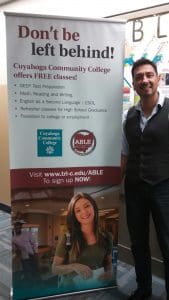 (This week is Adult Education and Family Literacy Week. It is a week to highlight the impact and importance of adult literacy not only on the students but on their families as well. Below is an inspiring story of one adult education student from the Tri-C Aspire program.)
(This week is Adult Education and Family Literacy Week. It is a week to highlight the impact and importance of adult literacy not only on the students but on their families as well. Below is an inspiring story of one adult education student from the Tri-C Aspire program.)